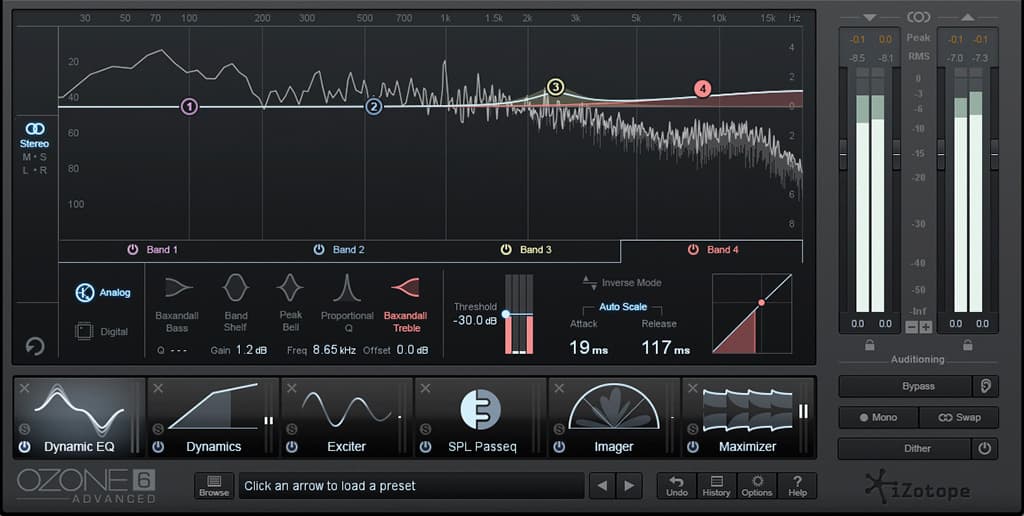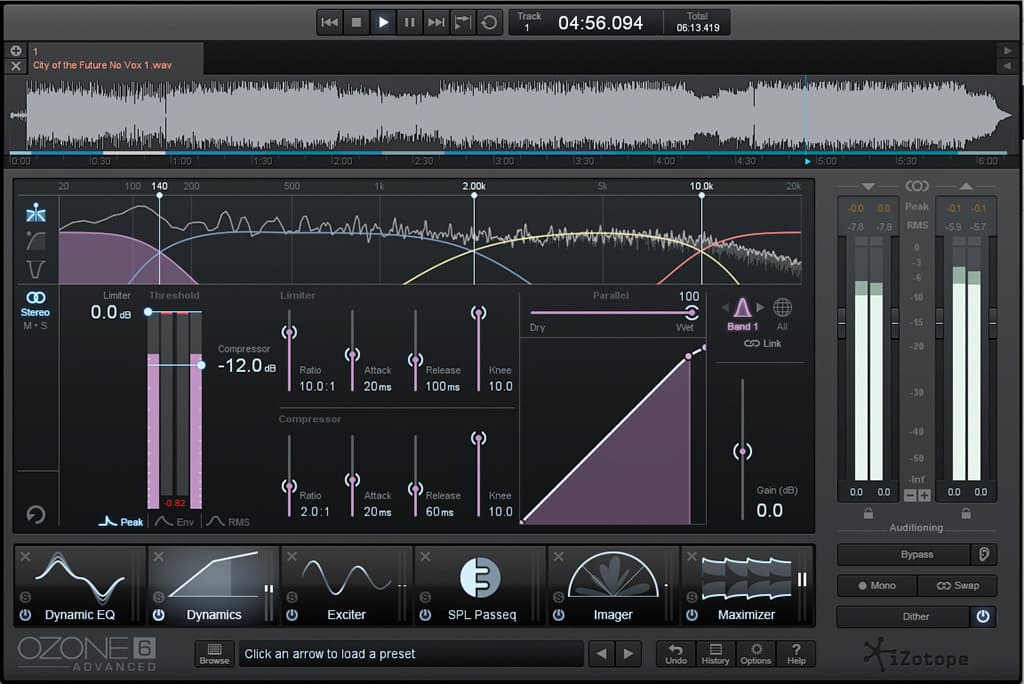
Review: iZotope Ozone 6 Advanced
Ozone’s interface has been reshuffled and a few things have gone missing. But Ozone Advanced users will have plenty of uses for the new Dynamic EQ.
Review: William Bowden
As a company, iZotope has been making a nice little name for itself over the years. Its flagship mastering application, Ozone, amazed many people with its feature set and price when it was released; and each year or so has seen progressive upgrades and improvements. In case you haven’t been keeping abreast, Ozone is an ‘all-in-one’ software mastering solution comprising EQ, harmonics generation, image manipulation, compression, output limiter and dithering.
A few years back iZotope began splitting products into Standard and Advanced versions, and I had the latter version of Ozone 6 on review.
So what’s the difference between Standard and Advanced? Well, I’d advise going to iZotope’s website and look at the handy comparison chart as there are quite a few differences (apart from $750!), but I will quickly focus on a couple here. Firstly the good news: Ozone 6 Advanced has a new dynamic equaliser and I have to say it works rather well. I may be getting a little ahead of myself here but this is the big carrot and one of the main reasons to choose the deluxe version over its pared back sibling. It also might be a reason for some people to consider upgrading from Ozone 5, though more on that later.
GREEN MEANS GO
So let’s start at the top then. Ozone 3, 4 and 5 all had similar looking interfaces and it was pretty easy to see the evolution progressing in terms of user interface and layout. Ozone 6 Advanced has a completely new grey look, layout, and in some areas, functionality. No more alien green, thank goodness. In use everything is very clearly labelled and whilst different to its forebears, I found it’s a piece of cake to get around. In terms of processing choices you have: EQ, Dynamic EQ, Maximiser, Imager, and Exciter. If you’re expecting to see the familiar Mastering Reverb — then sorry folks, it’s not here anymore, another slightly baffling move on iZotope’s part.
You do however have the ability to customise the order of your signal chain; as iZotope has finally broken each processing unit into modules that aren’t locked into a set cascade like they were in previous iterations. Swapping around modules is as easy as drag and drop, and new modules (up to a maximum of six) can be simply accessed from a palette. It’s also possible to do this in real time without a single glitch.
Also, instead of just an iZotope module you can now insert third-party plug-ins. This is a great idea and being able to use Ozone in and around other plugs opens up quite a few possibilities sonically. It saves a bit of CPU power too, as before you had to open up multiple instances of Ozone to achieve a similar workflow.
However, on the subject of CPU power there appears to be a major change in internal architecture. In previous Ozone releases the CPU load dropped or increased depending on the number of internal processors in use. Ozone 6 Advanced shows the same load regardless of whether all modules are in or out. This load is about the same as Ozone 5 with all processors turned on. Since we all value our CPU levels highly this does seems a trifle odd I must admit. Again, this is where the Advanced version’s single module plug-ins come in handy. As a reference, the solo Dynamic EQ plug-in loaded the CPU to about half the level of the full-blown Ozone package on my PC.
NEED TO KNOW

DYNAMIC ADDITION
There’s a lot of minutiae in an update to an all-in-one package like this. So I’ll focus on the new kid on the block, the Dynamic EQ. I’m quite familiar with my hardware dynamic EQs, namely the Tomo Audiolabs Lisa and the CLM Expounder. Essentially a dynamic equaliser allows you to add or subtract at a particular frequency, but modulates the amount of addition or subtraction based on a detected threshold (i.e. a compressor or expander). So if, for example, you want to boost the midrange in a vocal, but don’t when the vocal gets loud — then voila: dynamic EQ is the answer.
Ozone 6 Advanced has a four-band dynamic EQ with a good number of shapes available per band: Baxandall bass and treble shelves, band shelf, peak bell and proportional Q. Frequency range is 20Hz to 20kHz with linear phase and minimum phase available but only globally (sorry tweak-per-band freaks). The compression section features a wide-ranging threshold, attack (0-100ms), release (0-1000ms) and the compressor has an inverse function to allow expansion of boosts or cuts — great for reclaiming some lost dynamics or really killing something!
The boosts are limited to +15dB and the cuts to -30dB. Strangely though these values are only available if you type them in directly. If you just move the gain points in the graphic display then it’s limited to +5.4dB and -9dB — an oddly asymmetrical default range. Having said that, lifting out vocal regions, and giving guitars more shimmer or depth in MS was a joy with this equaliser. You really can make music sound better with this one module (or plug-in) alone. Per-band bypass makes life easy and having the ‘instant reset all bands to zero’ button was a nice touch too. Did I find any faults with this module? Not really, it’s very intuitive and sounds great. Does it face some stiff competition? Absolutely. Voxengo’s Gliss EQ springs to mind amongst others and it’s only $89. Melda Production’s MAutoDynamicEQ is a similar price and dare I mention Toneboosters’ TB Fix at just $20?




Ozone 6 lets you incorporate VST and AU plug-ins into its workflow, but there are already a lot of powerful tools in the package. Clockwise from top left: The Imager; the dynamics section; the exciter with new tube modes; and at the end of the chain, Izotope’s MBIT dither.
TRICKLE DOWN
While the Dynamic EQ is an Advanced feature only, there are a couple of worthy features that have trickled down from the Advanced version of Ozone 5 into the Standard version of 6. EQ Matching lets you take a source piece of music, analyse and capture its frequency spectrum profile, and impose it on another track (or sound). It’s quite an interesting and educational journey seeing how you can bring one tonal flavour of a mix closer to another. There are parameters for smoothing and amount — which help you decide how far you should go in copying someone else’s tone.
The Imager has a Stereoize function; which takes a mono source and applies some tricky processing to make it sound stereo. It can range from pretty useful to mildly electronic and phasey sounding. I just have the basic version of Ozone 5 myself, and finding comparison specs for Ozone 5 Advanced on iZotope’s site is no longer possible — it’s like it never existed.
For us mortals though Ozone 5 has very much existed and continues to endure. If Ozone 6 Advanced had been released without a forebear then this might be a fairly different review. As it is I found myself constantly comparing it to the previous release and often noticed things missing. Where’s the Reverb? I found this quite a useful tool and continue to do so. The Maximiser on Ozone 6 Advanced is missing a couple of features its predecessor carried, namely the Hard and Soft buttons, which have been replaced by more drop-down options under the IRC settings. A far more important omission in the new version are the Amount sliders. It might not sound like a big deal, but if everything is sitting really well and the client just wants a smidge more or a smidge less of everything, then a slider to vary the overall amount of processing takes a lot less time and is less prone to errors than going in and pulling it all down or up on individual bands. Try doing that on the multiband compressor and see how long it is before you start cursing.
To be fair, the Maximiser in Ozone 6 Advanced seemed to sound better than the one in version five — especially under heavy loads — though there wasn’t a huge difference in the ‘normal’ operating range. Similarly the new EQ seemed a bit more refined and subtle. Setting up what appeared to be the same values in Ozone 5 always resulted in a brasher sound, though that could usually be tamed by just turning it down a little. Finally, the new Exciter module definitely benefits from having two extra tube triode modes.
SUMMING UP
So to sum up there are many things to like in Ozone 6 Advanced. Apart from the main additions, there are funny little hidden quirks like a parameter randomiser — the kind of thing more at home in a virtual synth for people who need an oblique strategy every so often. You also can use Ozone 6 as a standalone app and have basic fade in and fade out control of a wave-file appearing at the top of the window (or several wave-files which you can tab between). It’s a useful mode of operation that draws your focus to the mastering process, and you’re not short-changed, especially now you can integrate other plug-ins directly into the Ozone workflow. There’s also a function which auto detects various changes in song structure and maps these as regions you can jump to — works like a charm.
Overall, it seems Ozone hasn’t really made the same kind of quantum leap in features it did when going from version four to five, and the market is extremely competitive now. The biggest changes are in the things users might not place as much value on, like GUI enhancements and workflow features. And although the GUI’s new look is inline with more celebrated modern plug-in designs, I found the graphical feedback a little rudimentary for a flagship product. It’s also not inexpensive at just under a thousand bucks. Will the basic version of Ozone 6 sell as well as Ozone 5 did? I would say it’s unlikely, it’s a hard act to follow.
As for my advice — try it in demo mode and see what you think. There are certainly sonic differences between 5 and 6 which may sway some people, and the upgrade pricing is worth a serious look for the Dynamic EQ. On that note, if you’re in Australia and considering buying Ozone 6 or an upgrade, make sure you head along to a local dealer. Electric Factory has pulled out all stops and ensured that it’s cheaper to buy local than online. Nice one!
Ozone 6 Advanced faces very stiff competition as many of its features are available from different and cheaper software houses, but once again iZotope provides a tried and tested all-in-one approach. Whether such an approach is the right one only time will tell, and alas, I am out of it folks.
















RESPONSES